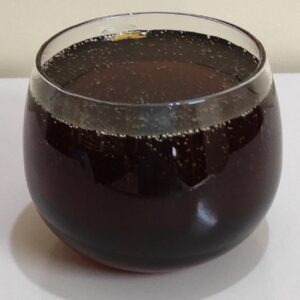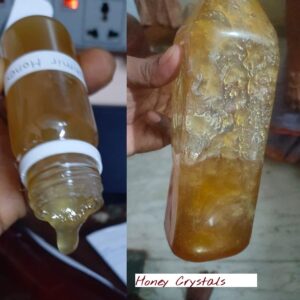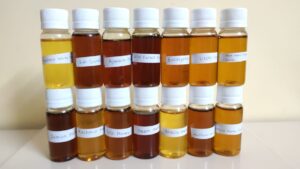1. Can I rely on thickness alone to check purity of honey?
Answer: Prematurely extracted honey tend to be less thick. But, thickness alone cannot be used to determine the quality as it depends on flower type and weather in the beekeeping area.
Explanation: Check the above video. Thickness is not the same for two different but original honeys. Kashmir white honey collected from Kashmir region is thicker than jamun honey collected from Punjab, though both are original & pure.
2. Why does honey have bubbles in it?

Answer: Protein content of honey is the reason for bubbles.
Explanation: Surface tension (physics) of a liquid determines its tendency to let air enter into the liquid and get trapped as bubbles. For example, you cannot make bubbles with plain water as it has high surface tension. By adding soap water, it’s surface tension can be reduced and then you can make bubbles. Similarly, due to the presence of amino acids(building blocks of protein) honey has low surface tension. This enables honey to let air get trapped in the form of bubbles [3] [4].
3. Why has my honey crystalized? Is it sign of bad quality?

Answer: Pure honey also crystalizes. It’s not a sign of bad quality. Keep it in sunlight or warm water to liquify and use it.
Explanation: Honey has natural glucose and fructose. Glucose has the tendency to freeze, which then separates from the rest of honey and appears like crystals/sugar. Jamun Honey, Acacia honey, Kashmir white honey has less tendency to crystalize as they have comparatively lower levels of glucose. Whereas, mustard honey crystalizes very fast. Some companies add chemicals to honey so that it doesn’t crystalize and looks “natural” [5][6]
4. What are the types of natural honey? What're monofloral and multifloral honey?
Answer: 1. Monofloral honey is what bees produce when they feed on single type of flower for making honey (neem honey, tulsi honey, rose wood honey etc.) 2. Multifloral honey is what bees produce when they feed on multiple types of flowers.
Explanation: Honey property depends on the type of flowers that bees visit. When farmers keep bee boxes in large tulsi farms, bees collect majority of it’s nectar from tulsi flowers and make tulsi honey.
Similarly manuka honey (world’s costliest honey), sidr honey, neem honey. These are monofloral honeys as majority (though not 100%) of the nectar is from a single type of flower. There are 300+ such natural monofloral types.
Honey is called multifloral when bees collect nectar from multiple types of flowers.
5. How can bees feed on only one type of flowers, to make monofloral honey?
Answer: When bees boxes are kept in large farms with plenty of single type of flowers, they collect majority of nectar from those flowers.
Explanation: Bees fly up to 3 kms till they find plenty of nectar producing flowers and water. Honey production would be low if the distance between the flowers and bee hive is high, as lot of energy and time gets spent in travelling, instead of making honey. That’s why, farmers identify large farms (tulsi farms etc.), migrate the boxes to that location during flowering season. When plenty of flowers are there, bees don’t have to travel far and will feed on nearby single type of flowers. Honey production would be also be high. Still bees may collect some nectar from other types of nearby flowers.
6. What's the color of pure honey?

Answer: Pure honey comes in various colors as shown in this pic.
Explanation: Color of honey depends on the type of flowers that bees feed on and weather of beekeeping area. It ranges from very light to yellow to very dark. Each honey has its unique taste, color, thickness, smell and benefits. Generally dark honey is consider healthy as it has high amount of antioxidants[7]
Since popular brands sell multifloral honey only, many tend to believe only one type of honey exists.
7. Is honey really different from common sugar?
Answer: Yes, they are different.
Explanation: Some tend to believe they both are very similar as fructose & glucose are major components of them. But, honey, additionally has useful enzymes, organic acids, minerals, other bio-active components[1].
- Unlike common sugar, original honey stored in airtight container does not expire
- Honey works as natural medicine against bacteria that developed resistance to man-made antibiotics[2]
If honey and sugar were similar, honey would not have above two proven properties.
8. Is honey always organic?
Answer: No. Honey collected from forests or pesticide-free area only is organic.
Explanation: Honey produced by keeping bee boxes in organic farms may be called organic honey. Still it may not be completely organic as pesticides might be used in adjacent farms, which some bees may visit.
Honey collected from forests is completely organic as there’s no agricultural, industrial activity in forests. Honey from acacia flower, which don’t need pesticides, and Kashmir region, due to low industrial activity, may also be considered organic.
9. Is honey produced by farmers (in bee boxes) as good as honey from natural bee hives?

Answer: Both are equally good. But, for moral reasons, honey produced in bee boxes is better.
Explanation: Farmers use wooden frames as shown in the picture. Just the outer frame is man-made. Bees make the internal wax cells and honey. That’s why honey is the same from bee boxes and natural hives. Farmers extract honey from these wooden frames without harming the bees. Extracting honey from natural hives is often harmful to the bees. Farmers can inspect the frames and extract honey only after it’s fully ripen. With natural hives, you may get unripen honey also as inspection before extraction is not possible.
10. How does honey get adulterated?
Answer:
Adulteration by
- Feeding bees excessively with sugar[8]
- Mixing honey with cheaper sweeteners like corn syrup
- Adding flavors
- Over Heating and industrial processing of honey
Explanation: When flowers are not available due to seasons/weather, some farmers feed bees with sugar excessively for survival. Ideally they should migrate the bees to better areas. Some sellers mix corn syrups (HFCS), which is cheaper than sugar, with honey. Some companies add artificial flavors and colors so that honey appears and tastes better than the original. Many sellers over heat, add preservatives, other chemicals. They do this to prevent honey crystallization and to reduce moisture content.
11. Can babies take honey?
Answer:
- 0 to 6 months of age : No
- 6 to 12 months of age : Probably, No.
- More than 12 months of age: Yes
Explanation: Honey may have bacteria called Clostridium botulinum, which causes no harm to older babies and adults. But in younger babies(<6 months, mostly), it might cause an illness (Infant botulism) due to immature digestive system.
In Asian countries, this is extremely rare. From 1997 to 2006, only 25 cases recorded in Asian countries (Japan 22, China, 2, Taiwan 1)[9]. None reported in India.
12. Can diabetic patients take honey?
Answer: Experiments conducted are inconclusive and contradictory;
Explanation: Some experiments showed positive benefits[10] of honey for diabetic patients while other showed contradicting results or no benefits[11]. Long-term full scale experiments are yet to be conducted.
Points against:
- Honey & sugar impacts blood sugar levels almost similarly
- Both have similar levels of carbohydrates
- Pure honey is costly and not easily available
Points in favor of:
- Honey is sweeter than sugar[12], hence less quantity is required
- Certain types of honey (jamun honey etc[13].) have lower levels of GI (glycemic index) than sugar. They don’t raise blood sugar levels as fast as sugar.
- Honey (Kshoudram, Pauthikam) was used in Ayurveda for treating diabetes[14]
- Anecdotal evidence claims diabetes can be controlled or “cured” by consuming raw jamun honey or neem honey instead of sugar
Because of these reasons, it’s not possible to conclude anything.
13. Where can I get the best honey?
Answer: Migratory beekeepers produce the best honey.
Explanation: Quality of honey depends on availability of good quality nectar producing flowers. Generally, no location has flowers throughout the year, due to seasonal, weather changes and agricultural practices. When flowers are not available, migratory beekeepers identify new areas with sufficient flowers and migrate bee boxes. Every time they move to a new place / farm, they produce a new type of honey (Litchi honey, neem honey etc.). They keep migrating and producing a different type of honey. It requires additional money for transportation, rents at new places, labor charges etc. To avoid these expenses, some farmers keep bee boxes in a fixed location and feed sugar to bees when flowers are not available.
Make a team of 20 people and buy best honey from migratory beekeepers, as they cannot sell small quantity. Otherwise, identify a retailer who buys from them and resell in small quantities.
References
[1] https://europepmc.org/article/PMC/5549483#sec2
[2] https://www.sciencedirect.com/science/article/abs/pii/S1744388107000771
[3] https://www.youtube.com/watch?v=8mQXFPyGw4M
[4] Beekeeping in the US, a book by department of agriculture
[5] https://www.youtube.com/watch?v=Z0Yyi66-IQk
[6] https://www.youtube.com/watch?v=JQm2Y1PRRcg
[7] https://www.sciencedirect.com/science/article/pii/S1018364721001087#s0070
[8] https://europepmc.org/article/MED/29572598
[9] http://www.smj.org.sg/article/infant-botulism-singapore
[10] https://www.ncbi.nlm.nih.gov/pmc/articles/PMC5817209/
[11] https://pubmed.ncbi.nlm.nih.gov/19817641/
[12] https://www.ncbi.nlm.nih.gov/pmc/articles/PMC3286380/
[14] https://www.cseindia.org/role-of-honey-in-ayurvedic-treatment-2638

